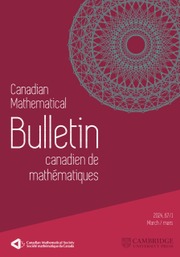Article contents
Automorphisms of Metabelian Groups
Published online by Cambridge University Press: 20 November 2018
Abstract
We investigate the problem of determining when  $\text{IA}({{F}_{n}}({{\mathbf{A}}_{m}}\mathbf{A}))$ is finitely generated for all
$\text{IA}({{F}_{n}}({{\mathbf{A}}_{m}}\mathbf{A}))$ is finitely generated for all  $n$ and
$n$ and  $m$ , with
$m$ , with  $n\ge 2$ and
$n\ge 2$ and  $m\ne 1$ . If
$m\ne 1$ . If  $m$ is a nonsquare free integer then
$m$ is a nonsquare free integer then  $\text{IA}({{F}_{n}}({{\mathbf{A}}_{m}}\mathbf{A}))$ is not finitely generated for all
$\text{IA}({{F}_{n}}({{\mathbf{A}}_{m}}\mathbf{A}))$ is not finitely generated for all  $n$ and if
$n$ and if  $m$ square free integer then
$m$ square free integer then  $\text{IA}({{F}_{n}}({{\mathbf{A}}_{m}}\mathbf{A}))$ is finitely generated for all
$\text{IA}({{F}_{n}}({{\mathbf{A}}_{m}}\mathbf{A}))$ is finitely generated for all  $n$ , with
$n$ , with  $n\ne 3$ , and
$n\ne 3$ , and  $\text{IA}({{F}_{3}}({{\mathbf{A}}_{m}}\mathbf{A}))$ is not finitely generated. In case
$\text{IA}({{F}_{3}}({{\mathbf{A}}_{m}}\mathbf{A}))$ is not finitely generated. In case  $m$ is square free, Bachmuth and Mochizuki claimed in ([7], Problem 4) that
$m$ is square free, Bachmuth and Mochizuki claimed in ([7], Problem 4) that  $\text{TR}({{\mathbf{A}}_{m}}\mathbf{A})$ is 1 or 4. We correct their assertion by proving that
$\text{TR}({{\mathbf{A}}_{m}}\mathbf{A})$ is 1 or 4. We correct their assertion by proving that  $\text{TR}({{\mathbf{A}}_{m}}\mathbf{A})=\infty$ .
$\text{TR}({{\mathbf{A}}_{m}}\mathbf{A})=\infty$ .
Keywords
Information
- Type
- Research Article
- Information
- Copyright
- Copyright © Canadian Mathematical Society 1998
References
- 3
- Cited by

